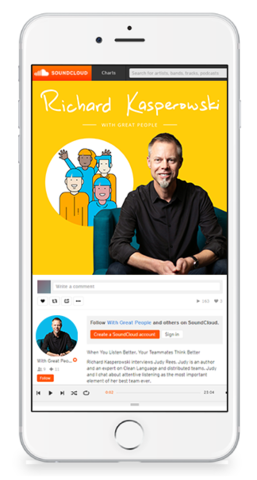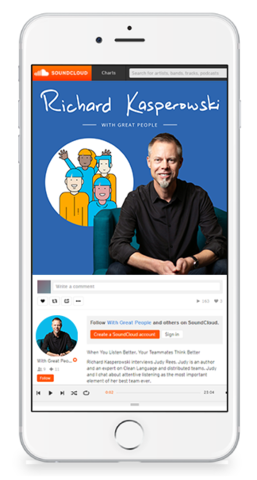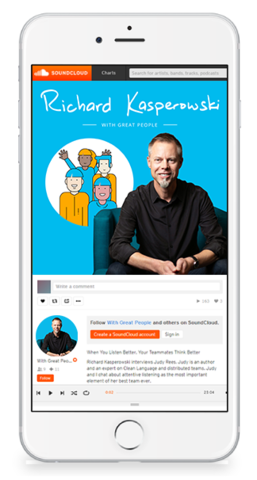Categories
A Really Good Team Is Rare. If You’re In One, Celebrate It!
This episode is an interview with Caitlin Walker. Caitlin is a specialist in creating the conditions for groups to collaborate, which is her modest way of saying that she is the world’s leading expert on Clean Language and Systemic Modeling. As Caitlin says during our conversation, “A really good team is rare. If you’re in one, celebrate it. They’re really precious. An exceptional team is such an amazing experience to be in. So don’t be so busy that you let it pass you by. … Life and work don’t get any better than this.”
You can email Caitlin at caitlin@trainingattention.co.uk and find her on LinkedIn.
Caitlin Walker: A Really Good Team Is Rare. If You're In One, Celebrate It!
with Caitlin Walker
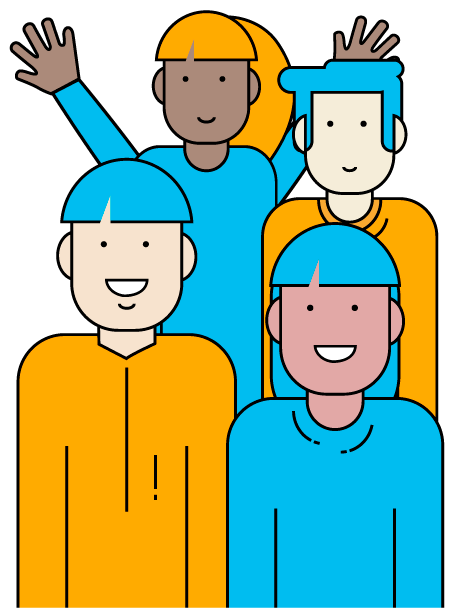
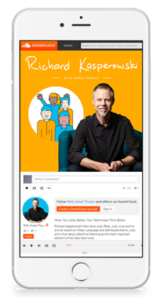
TRANSCRIPT
Richard: 00:10 Hi, friends. Welcome back to With Great People, the podcast for high performance teams. I’m Richard Kasperowski. This episode is an interview with Caitlin Walker. Caitlin is a specialist in creating the conditions for groups to collaborate, which is her modest way of staying that she is the world’s leading expert on clean language and systemic modeling. As Caitlin says during our conversation, a really good team is rare. If you’re in one, celebrate it. They’re really precious. An exceptional team is such an amazing experience to be in. Don’t be so busy that you let it pass you by. Life and work don’t get any better than this.
Richard: 00:49 You can email Caitlin at caitlin@trainingattention.co.uk and you can find her on LinkedIn. To support this podcast, sign up for my newsletter at Kasperowski.com. Thanks for listening. Our special guest today is Caitlin Walker. Welcome to the show, Caitlin. How are you?
Caitlin: 01:07 Oh, great, Richard. Thank you.
Richard: 01:10 Caitlin, can you introduce yourself to our listeners?
Caitlin: 01:13 Sure. My name is Caitlin Walker. I am a specialist in creating the conditions for groups to collaborate. The tools I use are clean language and systemic modeling. I’m talking to you from Liverpool. We’re in the middle of a big storm. I’m really excited to be here with you.
Richard: 01:31 Wonderful. All right. I actually want to hear a little bit more about clean language and systematic modeling. Can you give us a brief intro to that?
Caitlin: 01:40 Let me talk about clean first. The clean in clean language means without assumptions. As much as possible, a clean question directs the person that you’re… It directs their attention to what they were thinking or their own experience and it asks them to extend it. For example, if a colleague comes up to you say and says, “I’m really stuck,” you’d say, “What kind of stuck or you’re stuck like what?” What they do is the questions just extend their information just a little bit, but they don’t put your ideas in. It’s not that you can’t at all, but you ask a few clean questions, make sure you know what you’re dealing with, and then you could have a conversation about it.
Richard: 02:18 All right. That’s very different from the style of conversation that I grew up with. Even as I matured into an adult at work, it would be like, “Okay. What are you stuck on? I’ll help you get unstuck.”
Caitlin: 02:29 Yeah. It just stops you making those really quick assumptions. That tenth of a second. It creates a very, very small listening space between you and the other person.
Richard: 02:40 All right.
Caitlin: 02:42 I got really interested in it because I noticed a lot of miscommunication, a lot of wasted time and effort was simply because as you watch the communication, they didn’t listen to each other. They didn’t ask the question. They’re arguing furiously about the same point, you know, because they haven’t actually paid attention. That’s clean, and then systemic modeling is if you teach a few individuals in a group to do this, they can model themselves and one another simultaneously. Now modeling in this case is where as it’s not an ordinary conversation, it’s where you’re trying to get the model or structure of what’s being communicated to you.
Caitlin: 03:18 Systemic modeling is where each of you is doing that just a little bit in a group setting. A, it reduces contempt. It reduces miscommunication. But B, in paying attention to one another and yourself, you create incredible reflective learning space. The group become incredibly creative and responsive to what’s happening around them. They’re not high jacked by the chemicals that go with miscommunication. They’re free to think with systemic modeling.
Richard: 03:54 It’s interesting the way you talk about being high jacked by sort of the chemicals that shoot through your body and to your brain. It’s what cause you to behave in interesting, maybe weird, maybe counterproductive ways.
Caitlin: 04:10 The big thing about drama in a workplace is the minute you high jack… We all know this. The minute we’ve decided we don’t like someone, everything they do gets filtered through a narrow and narrower container where we go, “Yeah, that person is a negative person or this person is a saboteur.” You hear something you think disagree with and you don’t hear anything for the next five minutes because you’re waiting to argue. It really narrows the intelligence and limits the intelligence of each individual, but also at a group level. Particularly any organization that wants collaborative workers, it’s a good idea to reduce your drama and you can do that by increasing your attention through some questions.
Richard: 04:53 All right. Caitlin, this is the podcast about high performance teams. I’ve got a question that I like to ask when we have guests on the show. The question goes like this. What is your best team ever?
Caitlin: 05:07 Are you looking for a team I’ve been in or a team I’ve noticed?
Richard: 05:14 I’m thinking about a team you’ve been part of.
Caitlin: 05:17 Okay.
Richard: 05:17 It could be any sort of team, any group of two or more people that you’ve ever been a part of.
Caitlin: 05:23 For me, an ideal team is generally two. I like myself and one other.
Richard: 05:30 Yeah. All right.
Caitlin: 05:32 You’d think for somebody who spent her whole life creating conditions for other teams to work, I don’t work well with too many people around me.
Richard: 05:40 Okay.
Caitlin: 05:42 If I think about the best team ever, they’re slightly different for different ones. My best facilitating team was myself and a guy called Patrick Weeks. What’s amazing about that team is we were better together than I could ever have imagined. He was everything that I’m not. Then, I’m very wordy. I’m very good at detecting patterns. Patrick was really, really solid. He was extraordinarily good at getting the temperature of a group, of coming in with a light hearted joke, whereas I’m incredibly intellectual, and I could count who’s doing what in the group, and I could get everything very accurate.
Caitlin: 06:19 Together we were like a dream team and we were also very funny, very confident and professional trust with each other. Together as a whole, we could manage almost any group you put us in front of. It didn’t matter whether they were violent or high ego. Each of us balanced each other out. We didn’t step on each other’s toes. That’s facilitating, but if I was going to be writing a book, it’d be Marion Way. But it’s always similar. When I think about it, it’s high professional respect, trust, and that they’re not competing with me for my space. I get to be me and my capacity to the Nth degree and their stuff boosts it up and then my stuff boosts their stuff up.
Caitlin: 07:09 Together we’re really high performing, but we’re not stepping on each other’s toes and we’re not eating each other’s limelight. Do you eat limelight? But too many than that because I think if you think my job is to pay attention, really high attention to other people’s teams, I don’t want too many people in my own.
Richard: 07:31 Yeah. That’s interesting.
Caitlin: 07:32 Projects I like it to maybe three at the most, but that third person I like them to be somebody who’s just supporting us. I wouldn’t want to pay attention to more than one person and the people I’m working with.
Richard: 07:44 All right. Let’s sort of bring you back into one of those teams. Maybe you and Patrick, maybe you and Marion. When you bring yourself into one of those teams and yeah, totally cool that it’s two people. Most people think of a team as a larger group than that. When I define team, and I’m talking to people about teams, I actually define it as a group of two or more people aligned with a common goal. Perfect. If you bring yourself back to one of those duos, one of those two person teams, and like re-experience it, sort of feel the sensations in your body, maybe even close your eyes as you re-experience it, is there a single word that you could use to summarize the sensation of being part of that team?
Caitlin: 08:38 Flying.
Richard: 08:38 Flying?
Caitlin: 08:39 Yeah. You can soar because you know they’ll catch you.
Richard: 08:44 You can soar because you know they’ll catch you.
Caitlin: 08:50 They can soar because you’ve always got their back. No matter what I did, I knew he would be there for me. No matter what he did, I knew I’d be there for him.
Richard: 09:01 Right.
Caitlin: 09:06 It’s absolutely about… Both have really high standards in our own field. He had his and I had mine. We just admired one other’s, but we didn’t… Yeah, but it’s flying. Flying is the word for it.
Richard: 09:20 I love that. Whenever I’m talking to clean language or systemic modeling friends, I start to get really self-aware and anxious about asking great follow-up questions.
Caitlin: 09:33 Making sure you don’t add in nuance stuff.
Richard: 09:35 We should have printed the list of follow-up questions. What else about flying and just before flying?
Caitlin: 09:42 Interestingly because I didn’t know that these were the questions you’re going to ask, but we’ve just had a systemic modeling training last week. A really good international one. We were modeling an ideal collaboration for you is like what. I know the answer to these questions because I just had it modeled. For some people, it’s about trust. For others, it’s about fun. For me, it’s about absolute surety that somebody is 100% appreciative audience for me. Therefore, our egos… I’m not worried at all about him. I’m not anxious. All my attention is on the job or the project. There’s no worry about each of us if that make sense.
Richard: 10:27 Yeah. There’s trust. You know that he’ll catch you, you’ll catch him as you’re soaring. You’re not anxious. There’s no worries. There’s like mutual high professionalism, mutual expertise.
Caitlin: 10:40 That’s exactly the same with Marion. If I’m writing a book with Marion Way, it’s just the same thing. I would never challenge… If she challenged me about the way that the book was coming together, I would yield to her because I trust her. If I challenge her about the content, she would yield to me. Do you know like if you watch really brilliant dancers, they don’t have to negotiate. They are just are both doing their thing and they just are there to support one another.
Richard: 11:09 Right. Right. It’s like sometimes one is the leader. Sometimes the other is the leader. A good dance team like that.
Caitlin: 11:17 Absolutely. As I said, it feels like flying. Maybe more like the trees I guess.
Richard: 11:22 Oh, okay.
Caitlin: 11:22 Like a tree flying. That kind of flying.
Richard: 11:27 Yeah.
Caitlin: 11:27 Yeah. We were dazzling. It was dazzling to other people. I know it was rather an amazing audience. I guess because we would often go into groups that were high conflict and high fear because most companies don’t bring in an expensive consultant because they’re all doing fine. They’re generally bring you in because something’s going on. Pat and I were hugely diverse. Not just because he’s black and I’m white and he’s male and I’m female, but because our internal worlds were 100% different from each. Everything he liked, I hated. Everything I liked, he hated. Do you know? But we would use our diversity and our okayness with.
Caitlin: 12:13 We would stand for the possibility of what this group could do with these tools. We were a lovely expression of what we were teaching.
Richard: 12:24 Right. Did you and Pat ever have conflict?
Caitlin: 12:27 Oh, yeah. We’d have huge conflicts, but we use the stuff to manage them. In fact, I remember when we were running a big conference, Trade Union Congress, and we disagreed about something. We’d gone off to argue it through. We could have really high passionate arguments, but what we didn’t realize was that we were still being recorded with the webcam.
Richard: 12:53 Yeah.
Caitlin: 12:54 I mean I was furious with him and he was quite furious as well, but it was my stuff so I knew he’d yield to me. It wasn’t live in front of the client we thought. We sorted it out. We agreed what we were going to do. We came back on and we were the dream team again. Then afterwards, they called us and said, “You know, that was really interesting. Obviously we’re not going to broadcast it, but we’ve got this 20 minutes of you being really furious with each other. It was amazing to us that you used the tools.” We asked each other, what’s happening for you, what’s happening for me, what would we like to have happened, what’s the highest value, what are we here for.
Caitlin: 13:28 We used it to settle ourselves down and get a fresh path. Actually that then sold us to that company. Actually lots of my next two year’s worth of work came from the people who listened to that. They’re like, “We want to be able to do that.”
Richard: 13:47 Incredible.
Caitlin: 13:47 It was lucky that it didn’t just turn into [inaudible 00:13:51] It was an example.
Richard: 13:54 Could be your best promotional video ever, the 20 minutes of…
Caitlin: 13:59 Rowing.
Richard: 14:04 Yeah.
Caitlin: 14:04 Absolutely.
Richard: 14:06 All right. I guess I’m sort of geeky. I like to measure things or have metrics on things even if it’s subjective. For that duo, you and Pat, do you have any… What sort of opinions or feelings do you have that they give you a clue? You just told me a story about something that gives us a clue about what a great team it was. Do you have anything else that’s either subjective or objective? Any like hard metrics and anything else that’s about feelings or observations? Anything subjective or objective that somebody else could observe about what you were doing together and how it was such a great team?
Caitlin: 14:51 It was congruent with what we were doing. What we were talking about we demonstrated almost without fail. Even when we didn’t, even when we were incongruent, so supposing Pat started to become contemptuous of somebody that we were working with, I would say, “Let me just pause a minute. I’ll tell you what I’m noticing. Richard said this. Pat, do you know what? He doesn’t look like he’s interested. He looks like he’s in contempt.” Pat would know, he would know that I noticed and he would know that I was going to be okay with him not being okay.
Caitlin: 15:29 If I said, “Okay. Go in and work on this 15 minutes,” but then I wander off and make myself a cup of tea, Pat would call me on it in front of the group and say, “You know what? Caitlin said 15 minutes and I know she’s about to walk out the room, so I’m not sure what kind of a 15 minutes this is.” He wasn’t doing it to shame me and I wasn’t doing it to shame him. People would see that actually it’s okay to call people out when they’re not doing what they said they would do. It’s actually okay to fail here. We can get called out. We can bring it to attention. It doesn’t have to turn into a conflict. It doesn’t have to be humiliating.
Caitlin: 16:11 That’s the metric that you would see is that we were an example of what we wanted people to be. We were an example.
Richard: 16:18 An example of what you want people to be.
Caitlin: 16:21 Yeah, of the tools that we’re bringing to the group. We were a living example actually of how hard it could be as well. When you’re working with somebody… He likes everything done in order. He likes there to be an agenda, and you have to finish agenda point one before you’re allowed in agenda point two. My agenda looks like a spider’s web. I want to be able to go from agenda point seven to agenda point 10 because oh look, they’re linked. That would make him furious with me. We would use that difference with us between us to then talk to the group. He’d be like, “Hey. How many of you know that it’s best to do agendas in order,” and he’d get half the hands.
Caitlin: 16:59 I’d say, “How many of you know it’s best like a spider web,” and I’d get the other half of hands. He goes, “It’s really hard. She really frustrates me because she keeps doing this.” He said, “But what she can do that I can’t do is X.” Similarly, I go around and say, “But what he can do and I can’t do is Y.” It’s that. It’s the congruence. We were doing what the project needed us to do. I think that is a dream team. It doesn’t have to be easy, but from my mind it has to be exceptional given the purpose of what we’re together for.
Richard: 17:35 Yeah.
Caitlin: 17:45 Yeah.
Richard: 17:45 Yeah. I love the way that sounds. As you know, everybody listening is sort of filtering the words that they’re hearing from you and from me and I’m filtering the words I’m hearing from you through my recent experiences. I’m like, “Yeah. This is exactly what I’m doing with the client I’m working with right now.” We’re doing some agile software stuff. I’m trying to model for them agile software that’s best. We were spinning up sort of an executive team in the company, and we’re trying to get this executive team to model good agile teaming for the rest of the company. It’s really hard.
Caitlin: 18:21 You’re trying to demonstration that it works. You will be demonstrating the value of it through your behaviors.
Richard: 18:29 Yeah, exactly.
Caitlin: 18:31 Through the results that you behave is achieved. Yeah, that’s it.
Richard: 18:33 I’m trying to model it to them. I’m trying to get them to model it to everybody else. It really is challenging to sort of live the stuff that you hope your clients will do.
Caitlin: 18:45 Yes.
Richard: 18:46 Now what are some of the other… You mentioned a couple of concrete behaviors that you and Pat engage in together like noticing each other’s behavior and kind of calling each other out when something didn’t seem congruent. What were some other concrete behaviors that you engaged in together?
Caitlin: 19:05 Every morning or before going live, even if it was two minutes, we’d have a setup. You set your intention. We use it really swiftly. We’d like this project to be like what, you’d like to be like, “What do you need from me? What support do you need to do that?” It’s a very, very small intention, so that if there were any incongruencies in that moment, we could sort them out before we went live. We could do that for bigger things as well. If we were going to set a project, an amount of time suitable to whatever the size of the project is. If it’s a two hour meeting, it might be a two minute setup. But if it was a two week meeting, it might be a couple of hours.
Caitlin: 19:49 But we’d set our intention for the overall, for ourselves and for the support we needed from each other. Then every single time that we finished, we would have time set aside for what went well, what didn’t go so well, what we could be differently next time. Then set ourselves a developmental task as a result of that reflection. That happened without fail, which meant that our learning spiraled. Because even when things went wrong, that was great because we would learn more from them. Also, whenever they went wrong, they gave us stories to tell about how it had gone wrong. We amassed.
Caitlin: 20:39 Because we reflected on it, because we didn’t hide what had happened, A, it either provided great learning or it provided a great story and was very funny or it was just us learning how to do something better. No matter what happened… I’ll tell you what it is. It was anti-fragile. Those processed made us an anti-fragile pair. Because if it went wrong, it went right. If it went right, it went right. There was nothing bad was going to happen to us.
Richard: 21:12 You’re always finding things to… Well, I’ll add my own words. You’re always finding things to amplify out of the experience whether it was good or corrective from something that went wrong.
Caitlin: 21:21 Absolutely. It’s what I use about as well. We take it, amplify it, and then go, “Okay. What have we got here? What can we do from this?” If it’s something to move away from, that’s great. If it’s something to move towards, that’s great.
Richard: 21:36 Always improving.
Caitlin: 21:37 Absolutely.
Richard: 21:39 Any other concrete behaviors?
Caitlin: 21:41 Yeah. That was the setup. Another concrete behavior was when things did go wrong was that we unpacked our patterns. For example, I’m often late for things. I’m quite last minute. Pat was always so early it made me feel sick because you’d have to wait and I hate wasted time. Instead of just going, “Oh well, he’s like that and I’m like this,” we would create models of our experience. He’d say, “When you’re late for everything, what happens just before you’re late?” I say, “Well, you know, I look at the time and then I think back and fit one more thing in there.” He’ll say, “When you look at time, does it have a size or a shape?”
Caitlin: 22:23 He’d get a clear model of my model for time and then we’d swap and I’d get one for him. For you, times like what? I’d realize that mine’s like a moving suitcase that you got to keep as full as possible. His is much more of a rhythm. He has time is on and time is off. He needs to build up to things. He does the thing and then he needs to come down from things. For him, he can’t go from a standing start to being brilliant in front of the group. He needs to arrive. He needs to see the venue. He need to scope it out. He needs to have a nice cup of coffee. All this stuff for tracking is wasted time. The concrete behavior was that when there was diversity, when there were big differences, we would get interested.
Caitlin: 23:12 We get curious about it. We’d build a model. I’m not trying to become him and he’s not trying to become me, but we understand where we’re coming from. Then it’s a very short distance for him to say, “Well, I’d like to get there an hour before we start. What can I bring to make that hour useful for you so that it’s not wasted time for you,” or I’d go, “I know I’m going to make one more phone call just before we start with this client. How about you go for your coffee and I’ll go and stand outside with this? Will that be okay for you?” Just little tiny adjustments because we understood the way our systems work.
Caitlin: 23:52 Creating models of our diversity so that we made sense to each other. We did that regularly. Maybe once every two weeks we would spend a little bit of just developmental time, deep development time.
Richard: 24:06 Okay.
Caitlin: 24:10 Again, that’s true if I think about Marion Way. That’s true for Marion and I. We do that. We always do a set up a feedback. We do deep development time. Reflection in the moment and deep development time. Those are really key when I think about it to all the dream teams I’ve been with.
Richard: 24:30 Right. Set up time, reflection time and the deep modeling.
Caitlin: 24:40 Yes.
Richard: 24:40 We operate in very similar and different sorts of specialty areas.
Caitlin: 24:46 Mm-hmm (affirmative).
Richard: 24:48 If I put different jargon words on it, this is exactly the same thing that we do with agile software teams, right? We work into these short iterations. We always start with some setup for the two week tiny projects. We reflect at the end. We don’t necessarily call it modeling, but we’re looking for things to improve every time.
Caitlin: 25:11 I think when I was first introduced to agile as a movement or as an approach, I was like, “Oh, okay. That makes complete sense to me.”
Richard: 25:23 I’m doing the same thing listening to you.
Caitlin: 25:25 It was like, “Oh, yeah.” Of course, my stuff’s funny because it didn’t start in… Although I work many in the corporate world now, it didn’t start there. I started as a youth worker. I was developing a process to work with not necessarily gangs against each other, but certainly the kind of kids who would end up in gangs if we hadn’t done what we were doing. What I was developing was a way for them to pay attention to themselves and one another in a non-judgmental curious way to spot their own prejudices and their own contempt and then switch that into curiosity and see what happened.
Caitlin: 26:01 What happened was it very quickly went from these angry diverse groups of kids who hated each other, groups of individuals, to quite a strong high functioning team. Unless somebody had spotted me and said, “This stuff what you do with these teenagers, can it work in business,” I probably just would have stayed where I was. But of course, it works for business. Businesses are just grown up kids.
Richard: 26:27 Street gangs in office buildings.
Caitlin: 26:29 Absolutely. Armed with things that cut just as violently as their knife.
Richard: 26:38 What a funny way to look at it. What an interesting way to look at it. Street gangs in office buildings.
Caitlin: 26:43 It is. You all know what it’s like when there’s a bully in the office. Everybody’s creativity goes down. If there’s two leaders arguing with one another, if there’s issues, again, everybody’s creativity goes down because you switch brain states from your neocortex being at your best, being at your most creative and your most dynamic. You switch it into your mammalian, “Okay. What’s going on around here? Is this safe? Is this not safe? If I talk to you, will you tell somebody else?” That takes up so much of your brain activity.
Caitlin: 27:14 In that sense, what I was doing with the teenagers, which was to settle their brains and then get them on a high functioning state, of course, that’s what we want to in businesses. That’s where your productivity suddenly increases.
Richard: 27:27 Of course, that’s what we’d want to do outside of business as well. It’s great that you started there.
Caitlin: 27:35 We still spend at least 50% of our time as a company, we spend 50% of our time still out on the streets. If you work for me, you have to be comfortable in a board and you have to be comfortable with teenagers. We do that to help our trainers to become high functioning, to get out of their comfort zones.
Richard: 27:59 I really admire the work that you do and that you’re not strictly into business world like that.
Caitlin: 28:01 Yeah. Also, it’s great fun. You know?
Richard: 28:07 Of course.
Caitlin: 28:07 They’re hilarious and then you learn that you don’t feel so embarrassed because you know what the latest slang terms are.
Richard: 28:11 Oh, yeah. Then you look really cool when you’re in the boardroom.
Caitlin: 28:19 Absolutely. It’s true.
Richard: 28:22 How about some advice for our listeners? What can they do to reproduce some of the success that you’ve experienced with your best teams?
Caitlin: 28:30 The first thing is to be really clear about what you’re good at and really clear what doesn’t float your boat. What are you just not motivated to excel at? Find somebody else to work with you who will do that stuff for you. Not even for you, but somebody who loves that stuff. The first thing is that level of self-awareness and then make sure that you make models of other people you’re going to work with so you can check is this a good fit? Is this person going to compete for my limelight? Because somebody who might seem really great and really dazzling actually you might find that they’re too like you.
Caitlin: 29:15 If you’re sort of a backseat person, you probably don’t want another backseat person with you because otherwise together you’re a bit dull. Know yourself is the first thing. Second, get yourself… Like you have in agile, get yourself some habits and make them a rule. Make good habits compulsory. It makes a huge difference because then you don’t forget about it. It’s just the way we do things. You get up in the morning, you brush your teeth. It’s just the way we do things around here. It’s like you start project, you make sure you do a setup. You make sure there’s space for reflection and you make it okay to fail.
Caitlin: 29:54 If you put those rules in, and we have another rule actually. In fact, this is probably what I didn’t tell you about, but it’s really, really important. There is nothing that I’m going to say about you that I wouldn’t say to your face. With our company, it’s absolute rule. If you really annoyed me and I’m so angry I can’t talk to you, but maybe I’m going to go and talk to Marion about you, she’ll listen. She’ll let me power bitch and calm down, but then she’ll say, “How can I support you to give him that feedback?” I think that’s another thing in a high performing team is that you don’t let things fester.
Caitlin: 30:32 You have some mechanism to respectfully say what’s true. If you get into drama with people, respectfully say what’s going on for you.
Richard: 30:40 Right. Don’t let things fester. Respectfully say what’s going on for you.
Caitlin: 30:47 Yeah. I think that just means giving some space. If I go, “Rich, I’m so annoyed with you because you did this,” but that we recognize that my being annoyed and you doing X, it’s not that one X causes Y, but you may or may not have been doing what I imagined you were doing and you have a perfect right to be who you are. It’s enough space that me being annoyed doesn’t mean you’re a bad person or me being annoyed doesn’t mean I’m a bad person. It just means for some reason at this point our behaviors and our patterns have clashed. Get yourself some rules that keep you in an I’m okay, you’re okay position.
Richard: 31:31 Right. Get yourself some rules to keep you both okay, I’m okay, you’re okay.
Caitlin: 31:34 Yup.
Richard: 31:34 Is there anything else you’d like to add?
Caitlin: 31:41 They’re rare in my experience. A really good team is rare.
Richard: 31:44 All right. A really good team is rare.
Caitlin: 31:47 If you’re in one, celebrate it. They’re really precious. An exceptional team is such an amazing experience to be in. Don’t be so busy that you let it pass you by. Actually stop for a minute and go, “Do you know what? This is great. Life and work don’t get much better than this.” This is just… Kurt Vonnegut, the writer, he said… I think his grandfather had the same way. Just go, “Yup. This is it. Life doesn’t get much better than this right now. It’s happening right now.” Taking a moment to really appreciate what you’ve got.
Richard: 32:32 I love that. That’s beautiful. One of my best teams ever, maybe my best team ever, is my wife Molly and me. It’s a duo. Kind of like what you’re talking about. I’m great in small teams. I can’t wait until she gets home today and I can share this conversation with her and be like, “Yeah. We have something really great here. Let’s celebrate it.”
Caitlin: 32:55 Yeah. Just go, “Aren’t we lucky? How lucky we are to found each other, to find somebody that makes me look better or be better that I could be on my own.” It’s a very precious thing.
Richard: 33:08 Yeah. Yeah, for sure. I’m feeling this like deep in my belly right now. If our listeners want to get in touch with you, is there a way they can do that?
Caitlin: 33:24 Oh yeah. You can always email me. It’s caitlin@trainingattention.co.uk. Training Attention is just because I think a lot of this stuff is about where you put your attention affects what you get. That’s why we call the company Training Attention. If you look me up on LinkedIn, I usually come up. I love to talk. If you’ve got projects and ideas, I really like to bat ideas around. We go all over the world. We’re going to be in Boston, me and you, in a couple of months. If you got ideas or you want to know how you might be a bit cleaner, give us a shout.
Richard: 34:06 All right. Caitlin, thank you very much for joining us today. I really enjoyed the conversation.
Caitlin: 34:12 Yeah. It’s bene lovely to talk to you. Thank you for that.
Richard: 34:15 Hi, friends. Thanks for listening. Remember, to support this podcast, sign up for my newsletter at Kasperowski.com.



